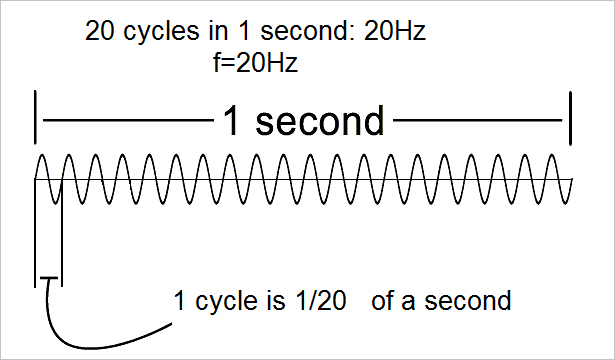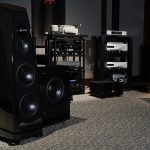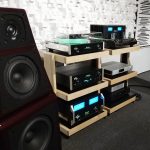What frequencies are Bass?
by Charlie Santmire
Most people don’t equate music with frequency (frequency is cycles per second, now called Hertz “Hz”). We do. It’s essential that we equate musical instrument ranges to frequency to get the best result from speakers and woofers. So here is a look at the issues and my definitions of ranges.

LOWER MIDRANGE (80-160 Hz octave/E2 to E3)
Many instruments and voices (baritone and bass) have notes in this range. E2 is the lowest note on a guitar and on the Tympani (tuned drum).
BASS AND UPPER BASS (40-80 Hz/Eto E2)
Actually, 41.02 Hz for E1 to 82.4 Hz for E2. For normally tuned bass guitar and upright double bass, note fundamentals extend down to E1, (open E). I would consider bass arbitrarily to be below C2 (65.41 Hz). That is two octaves below middle C. The fundamental of a note is its musical pitch. It is also called the first harmonic. The second harmonic is thus twice the pitch frequency and so forth. Harmonics are generally the fundamental times 2, 3, etc.
DEEP BASS (Below 40 Hz)
Some acoustic instruments and electronic instruments have fundamentals in this range. This range is very difficult to reproduce at a level you can hear with acceptably low distortion. An upright bass with extension goes down to C1 (32.7Hz). The lowest note on a piano is A0 (27.5 Hz). The fundamental of this note A0 is quite audible on a 9′ concert grand – not audible on a spinet (small upright piano).
Double bass with extension and a concert grand piano can produce reasonable levels of their lowest fundamental frequency. Contrabassoon can play C1 but the fundamental is essentially absent. You might ask if you can’t here the fundamental why bother to be able to play the note. The answer is that we place the note in our mind by the interval between the harmonics. So, we know a piano is playing A0 (27.5 Hz) because we hear the harmonic structure 55Hz, 82.5Hz etc. even if we cannot hear much of the fundamental.
VERY DEEP BASS (C0 to C1/16.35Hz to 32.7Hz)
Only electronic instruments and pipe organ sound in this range. Big pipe organs will have more than one rank (set of 24 pipes) covering this range. C0 requires a 32′ pipe. There are a couple of organs with 64′ pipes. They can sound at 8Hz.
All of these frequencies assume normal current tuning where A4 is 440Hz.
BASS IMPACT
Bass impact is a totally different issue. You need to move a lot of air very quickly to get impact. This is difficult and expensive to do. It is an important aspect of music with kick drum and concert bass drum. The speaker must react forcefully and quickly. The room also enters into the equation. We are investigating this area of reproduction. Stay tuned. More to come on this.
BASS INTENSITY
Moderate levels in the midrange where most music is centered are in the range of 80dB SPL (Sound Pressure Level) or so. Zero dB SPL is a defined arbitrary level. The lowest levels we can typically hear are in the 10-20dB SPL range. Equal loudness to that 80 dB SPL level in the midrange at very low frequencies (30Hz or so) is generally considered to be about 110 dB SPL. This level is very difficult and very expensive to produce in an audio system.
STEREO SUBWOOFERS
Most larger floorstanding speaker systems should try for 40Hz with low distortion and fairly high levels. To effectively extend response another octave to 20Hz at appropriately high levels requires subwoofers. Our experience is that it is not possible to position the main speakers for maximum output in this octave, even if they can reproduce it, and at the same time position them for best overall musical performance above 40Hz. They would need to be quite close to the wall behind them to benefit from that reinforcement. We all know that placement sounds very bad as the whole musical tonal structure is influenced negatively by reflection from that wall.
Stereo subwoofers are a must, not single subwoofers. Stereo subwoofers extend the bass and “open up” the midrange, giving a sense of space, the space in which the music was performed. If an acoustic instrument recording is made in a concert hall you will then hear the hall, the space in which the music was performed. A single subwoofer will get you some sense of this space and may give you more bass than no subwoofer but that depends on the individual recording. To the extent that bass has different phase in the recording between left and right channels, the bass may partially cancel with a single subwoofer.
THE LISTENING ROOM IS ALSO INVOLVED IN BASS REPRODUCTION
The room modes (emphasizing or deemphasizing certain frequencies at different places in the room) depends on the size and stiffness of the room. Your sitting position will be at a place where the loudness of some frequencies (notes) will be greater or less than at others. You can do a lot of math and calculate these boosts and cuts. You can also make measurements.
In my view, the best you can do is listen to examples of the music you typically listen to and move your listening seat around a little bit, if you can, to see if you like the bass better in one position or another. Stereo woofers tend to smooth out the bass to some extent and I also find that sitting a bit off-center may also help. Often a couple will have two chairs together each being a bit off-center of the width of the room. I find this to be fine in all aspects of listening if you are a bit further from the plane of the speakers than the speakers are apart on centers. We can help you with all this fine detail.
Setting up stereo woofers is as much an art as a science. You start with the science but what makes things really work is the art of setup developed through the experience of doing many setups.




